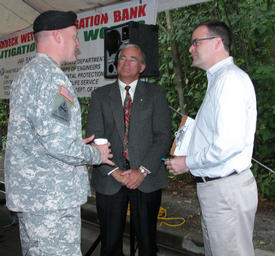 Washington's first wetland bank celebrates success
Washington's first wetland bank celebrates success

Seattle District Commander Col. Anthony Wright discusses mitigation banking with Snohomish County Airport Director Dave Waggoner and Pete Mills, of Congressman Jay Inslees office. (Photo by Pamela Graesser)
Dec. 22, 2008
Frogs and birds rustle in the undergrowth hidden by thick young alders in a wetland laboratory of a sort in south Everett, Wash., while dignitaries and volunteers gather nearby to celebrate the creatures' soggy home.
The Paine Field mitigation bank was the first bank ever approved by the regulatory agencies in the state of Washington.
In April, regulatory agencies determined the bank sites had matured enough to be considered an ecological success, allowing the entire site to be made available for mitigation. Agency officials, community leaders and volunteers gathered Sept. 25 to celebrate the final approval.
"This bank was only possible through the collaborative efforts of the federal and state agencies, Snohomish County and the airport nearly a decade ago," said Col. Anthony Wright, commander of the Seattle District.
In 1996, Snohomish County began developing a wetland mitigation bank with the help of the Department of Ecology, the U.S. Environmental Protection Agency (EPA), the U.S. Army Corps of Engineers and the Federal Aviation Administration. Evan Lewis and Gail Terzi were the Corps' key players in the effort, along with Snohomish County Airport's Bill Lewallan (also known to local volunteers as the 'Frogfather') and a multi-agency team.
As a regulatory agency, the Corps must balance the need for development and protection of the environment. Mitigation banking is a product of that need for balance, providing wetland functions in advance of impacts and improving the certainty of mitigation success.
The bank is actually two separate sites, Swanson and Narbeck - that provide 58 acres of wetlands and buffers - 13 and 45 acres respectively. The sites provide storm and floodwater storage, wildlife habitat for small mammals, amphibians, and aquatic insects, and environmental education with a shelter, nature trail, interpretive signs and greenhouse for the public.
Built in 1998, this project came a decade before the enactment of the federal government's mitigation rule, which encouraged mitigation banking this summer.
The EPA and the Corps issued new federal rules regarding mitigation in June 2008. To reduce risk and uncertainty and help ensure that the required compensation is provided for wetland impacts, the rule established a preference hierarchy for mitigation options. The most preferred option is mitigation bank credits, which are usually in place before the activity is permitted. However, the mitigation sequence (first avoid, then reduce, then mitigate impacts) is retained in this rule.
"The future of wetland mitigation will look like the Paine Field bank," said Jay Manning, director of the Department of Ecology. "We can use this project as a model, applying the lessons learned from this banking approach to future projects throughout the state."
"Our region's wetlands and small streams are not only home to salmon and other threatened and endangered wildlife, but they also prevent flooding and protect us from storm damage," said Elin Miller, EPA�s region 10 administrator. "Our new wetland mitigation rule will help ensure ecological success, while providing greater consistency and predictability for property owners and developers."
Thanks to Lewallen, and a host of forward-thinking individuals at all levels of government, future county airport projects can tap into the bank's credits to offset wetland losses that cannot be avoided, and community members - people, birds, frogs and bugs - can enjoy a peaceful retreat in the heart of south Everett.
The U.S. Army Corps of Engineers, Washington State Department of Ecology, U.S. Environmental Protection Agency and Snohomish County all contributed to this story.
Added on 12/22/2008 09:10 AM
Updated on 12/22/2008 09:15 AM